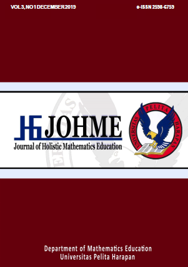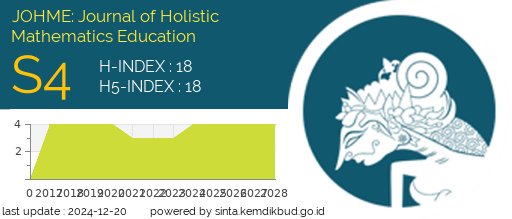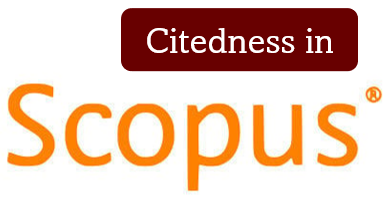ANALISIS KESALAHAN MAHASISWA PENDIDIKAN MATEMATIKA DALAM MENYELESAIKAN SOAL GEOMETRI PADA TOPIK BANGUN RUANG [ERROR ANALYSIS OF STUDENTS IN THE MATHEMATICS DEPARTMENT IN SOLVING GEOMETRY PROBLEMS ON THE TOPIC OF SOLID FIGURES]
DOI:
https://doi.org/10.19166/johme.v3i1.1708Schlagworte:
analisis kesalahan, geometri, bangun ruang, error analysis, geometry, solid figuresAbstract
Geometry is a branch of science in mathematics and a course taken by students of mathematics education. Based on students' final exam scores, results were not optimal with several types of errors detected. This study aimed at identify student mistakes in solving geometry problems on the topic of solid figures. The subjects of this study were mathematics education students in the even semester of the 2018/2019 academic year at Universitas Pelita Harapan in Tangerang. The type of research was a qualitative descriptive study. The data collection technique used was a test. The results showed that students' errors in solving geometry problems were concept errors, calculation errors, and a lack of accuracy because they were in a hurry.
BAHASA INDONESIA ABSTRACT: Geometri merupakan salah satu cabang ilmu dalam matematika dan merupakan matakuliah yang wajib diikuti oleh mahasiswa program studi pendidikan matematika. Berdasarkan nilai ujian akhir semester mahasiswa didapatkan hasilnya masih kurang maksimal, hal ini memungkinkan terdapat beberapa tipe kesalahan jawaban dari mahasiswa. Penelitian ini bertujuan untuk mengidentifikasi kesalahan mahasiswa dalam menyelesaikan soal UAS geometri pada topik bangun ruang. Subjek penelitian ini adalah mahasiswa pendidikan matematika semester genap Universitas Pelita Harapan Tangerang tahun akademik 2018/2019. Jenis penelitian ini adalah penelitian deskriptif kualitatif. Teknik pengumpulan data yang digunakan adalah tes. Hasil penelitian menunjukkan bahwa kesalahan mahasiswa dalam menyelesaikan soal geometri adalah kesalahan konsep, kesalahan hitung, dan kurang teliti karena terburu-buru.
Literaturhinweise
Bird, J. (2002). Matematika dasar: Teori dan aplikasi praktis. Jakarta, Indonesia: Erlangga.
Dirgantoro, K. P. S., Saragih, M. J., & Listiani, T. (2019). Analisis kesalahan mahasiswa PGSD dalam menyelesaikan soal statistika penelitian pendidikan ditinjau dari prosedur Newman. JOHME: Journal of Holistic Mathematics Education, 2(2), 83-96. https://doi.org/10.19166/johme.v2i2.1203
Retnawati, H., Arlinwibowo, J., & Sulistyaningsih, E. (2017). The students’ difficulties in completing geometry items of national examination. International Journal on New Trends in Education and Their Implications, 8(4), 28-41. Retrieved from http://www.ijonte.org/FileUpload/ks63207/File/03.heri_retnawati.pdf
Ketterline-Geller, L. R., & Yovanoff, P. (2009). Diagnostic assessements in mathematics to support instructional decision making. Practical Assessement, Research & Evaluation, 14(16), 2-11. Retrieved from https://pareonline.net/getvn.asp?v=14&n=16
Luneta, K. (2015). Understanding students’ misconceptions: An analysis of final grade 12 examination questions in geometry. Pythagoras, 36(1), 1-11. https://doi.org/10.4102/pythagoras.v36i1.261
Luneta, K., & Makonye, P. J. (2010). Learner errors and misconceptions in elementary analysis: A case study of a grade 12 class in South Africa. Acta Didactica Napocensia, 3(3), 35-46. Retrieved from https://files.eric.ed.gov/fulltext/EJ1056125.pdf
Mirna, M. (2018). Errors analysis of students in mathematics department to learn plane geometry. IOP Conference Series: Materials Science and Engineering, 335(1), 1-4. https://doi.org/10.1088/1757-899x/335/1/012116
NCTM. (2000). Principles and standards for school mathematics. Reston, VA: The National Council of Teachers of Mathematics, Inc.
Negoro, S. T., & Harahap, B. (2005). Ensiklopedia matematika. Bogor, Indonesia: Ghalia Pustaka.
Ozerem, A. (2012). Misconception in geometry and suggested solutions for seventh grade students. Procedia - Social and Behavioral Sciences, 55, 720-729. https://doi.org/10.1016/j.sbspro.2012.09.557
Raifana, S. N., Saad, N. S., & Dollah, M. U. (2016). Analisis jenis kesilapan melalui kaedah newman error dalam penyelesaian masalah berayat matematik dalam kalangan murid tahun 5. Jurnal Pendidikan Sains dan Matematik Malaysia, 6(2), 109-119. Retrieved from http://ir.upsi.edu.my/1077/
Ruseffendi, E. T. (1995). Materi pokok pendidikan matematika 3. Jakarta, Indonesia: Depdikbud.
Sari, E. P., & Gunanto, Y. E. (2018). Penerapan metode giving questions and getting answers untuk meningkatkan keterampilan berpikir kritis siswa kelas X-MIA di sekolah ”˜Fanós’ Kupang. Polyglot: Jurnal Ilmiah, 14(2), 239-253. https://doi.org/10.19166/pji.v14i2.846
Siregar, E., Nara, H., & Jamludin. (2010). Teori belajar dan pembelajaran. Bogor, Indonesia: Ghalia Indonesia.
Soedjadi, R. (2000). Kiat pendidikan matematika di Indonesia: Konstatasi keadaan masa kini menuju harapan masa depan. Jakarta, Indonesia: Direktorat Jenderal Pendidikan Tinggi, Departemen Pendidikan Nasional.
Surya, I. T. M., Suastika, I. K., & Sesanti, N. R. (2019). Analisis kesalahan siswa dalam menyelesaikan soal-soal materi operasi bentuk aljabar berdasarkan tahapan Newman di kelas VII SMP NU Bululawang. Jurnal Terapan Sains & Teknologi (RAINSTEK), 1(1), 25-33. Retrieved from http://ejournal.unikama.ac.id/index.php/jtst/article/view/3058/2110
Susanto, A. (2018). Teori belajar & pembelajaran di sekolah dasar. Jakarta, Indonesia: Prenada Media.
Yuniarti, Y., Kusumah, Y. S., Suryadi, D., & Kartasasmita, B. G. (2017). The effectiveness of open-ended problems based analytic-synthetic learning on the mathematical creative thinking ability of pre-service elementary school teachers. International Electronic Journal of Mathematics Education, 12(3), 655-666. Retrieved from https://www.iejme.com/download/the-effectiveness-of-open-ended-problems-based-analytic-synthetic-learning-on-the-mathematical.pdf
Van de Walle, J. A. (2012). Matematika sekolah dasar dan menengah: Pengembangan pengajaran. Jakarta, Indonesia: Erlangga.Downloads
Veröffentlicht
Zitationsvorschlag
Ausgabe
Rubrik
Lizenz
Authors who publish with this journal agree to the following terms:
1) Authors retain copyright and grant the journal right of first publication with the work simultaneously licensed under a Creative Commons Attribution License (CC-BY-SA 4.0) that allows others to share the work with an acknowledgement of the work's authorship and initial publication in this journal.
2) Authors are able to enter into separate, additional contractual arrangements for the non-exclusive distribution of the journal's published version of the work (e.g., post it to an institutional repository or publish it in a book), with an acknowledgement of its initial publication in this journal.
3) Authors are permitted and encouraged to post their work online (e.g., in institutional repositories or on their website). The final published PDF should be used and bibliographic details that credit the publication in this journal should be included.”










